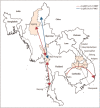Artemisinin and multidrug-resistant Plasmodium falciparum - a threat for malaria control and elimination
- PMID: 34267045
- PMCID: PMC8452334
- DOI: 10.1097/QCO.0000000000000766
Artemisinin and multidrug-resistant Plasmodium falciparum - a threat for malaria control and elimination
Abstract
Purpose of review: Artemisinin-based combination therapies (ACTs) are globally the first-line treatment for uncomplicated falciparum malaria and new compounds will not be available within the next few years. Artemisinin-resistant Plasmodium falciparum emerged over a decade ago in the Greater Mekong Subregion (GMS) and, compounded by ACT partner drug resistance, has caused significant ACT treatment failure. This review provides an update on the epidemiology, and mechanisms of artemisinin resistance and approaches to counter multidrug-resistant falciparum malaria.
Recent findings: An aggressive malaria elimination programme in the GMS has helped prevent the spread of drug resistance to neighbouring countries. However, parasites carrying artemisinin resistance-associated mutations in the P. falciparum Kelch13 gene (pfk13) have now emerged independently in multiple locations elsewhere in Asia, Africa and South America. Notably, artemisinin-resistant infections with parasites carrying the pfk13 R561H mutation have emerged and spread in Rwanda.
Summary: Enhancing the geographic coverage of surveillance for resistance will be key to ensure prompt detection of emerging resistance in order to implement effective countermeasures without delay. Treatment strategies designed to prevent the emergence and spread of multidrug resistance must be considered, including deployment of triple drug combination therapies and multiple first-line therapies.
Copyright © 2021 The Author(s). Published by Wolters Kluwer Health, Inc.
Conflict of interest statement
Figures



References
-
- Nosten F, White NJ. Artemisinin-based combination treatment of falciparum malaria. Am J Trop Med Hyg 2007; 77: 6 Suppl: 181–192. - PubMed
-
- Nosten F, Luxemburger C, ter Kuile FO, et al. . Treatment of multidrug-resistant Plasmodium falciparum malaria with 3-day artesunate-mefloquine combination. J Infect Dis 1994; 170:971–977. - PubMed
-
- World Health Organization. Guidelines for the treatment of malaria. Geneva, Switzerland: World Health Organization; 2006.
Publication types
MeSH terms
Substances
Grants and funding
LinkOut - more resources
Full Text Sources
Research Materials

